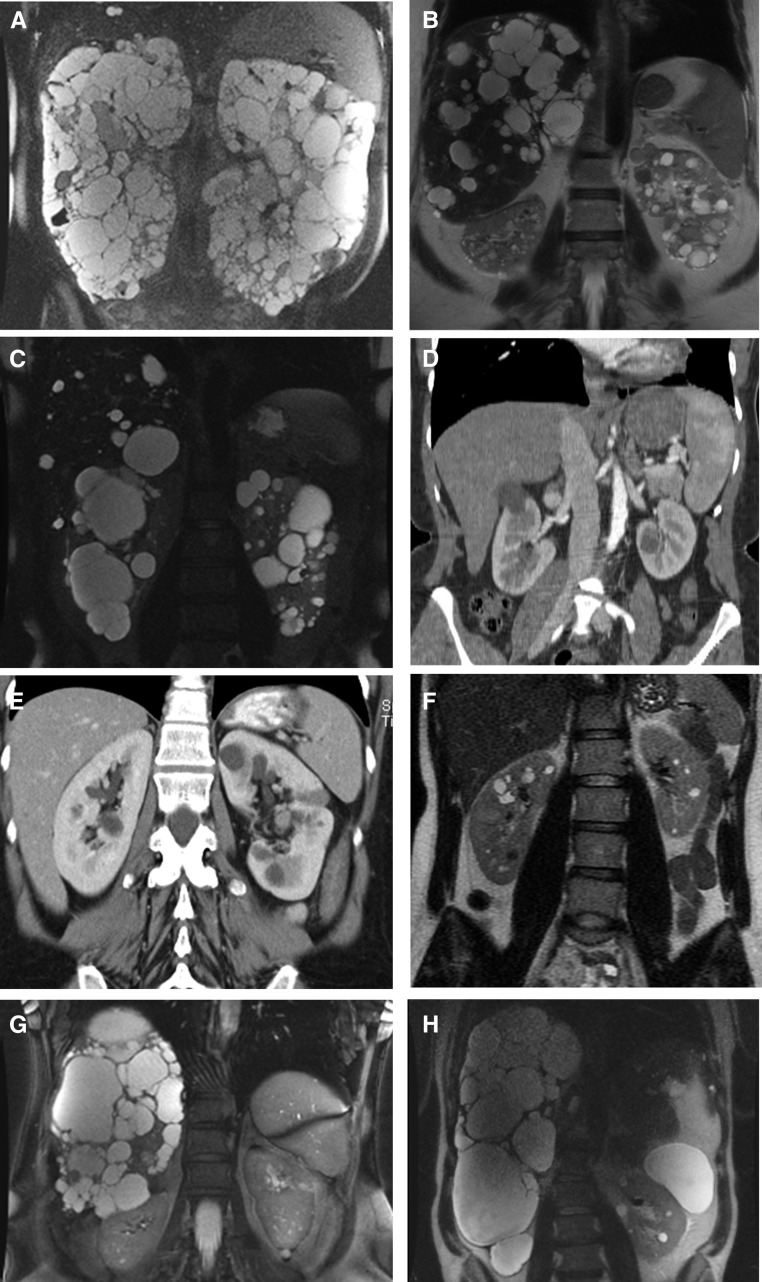Figure 1.
These eight kidney and liver images illustrate the different genic and allelic forms of ADPKD and ADPLD, and the most frequent differential diagnosis. (A) ADPKD-PKD1T: MRI of a 45-year-old male patient with a truncating PKD1 mutation (c.4880_4883delATGT; p.Tyr1627fs), who has an eGFRCKDEPI=15.1 ml/min per 1.73 m2 and HtTKV=3853 ml/m. (B) ADPKD-PKD1NT: MRI of a 55-year-old woman with a PKD1 nontruncating mutation (c.2180T>C, p.Leu727Pro) with well preserved kidney function (eGFR=63.4 ml/min per 1.73 m2) and HtTKV=439 ml/m. Significant PLD is present. (C) ADPKD-PKD2: MRI of a 53-year-old man, with a PKD2 mutation (c.1057G>A, p.Glu353Lys), who has well preserved kidney function (eGFR=68.6 ml/min per 1.73 m2) and HtTKV=1245 ml/m. Note that a few large cysts in the right kidney largely explain the enlarged HtTKV. (D) ADPKD-PKD1 ULP: Contrast-enhanced CT-scan of a 48-year-old woman, with a ULP PKD1 nontruncating mutation (c.9829C>T, p.Arg3277Cys), who has a total of five cysts in the right kidney and one cyst in the left kidney, a normal eGFR, and nonenlarged kidneys. (E) ADPKD-GANAB: CT-scan of 45-year-old woman with a GANAB mutation (c.1914_1915delAG; p.Asp640fs) who has bilateral kidney cysts, a normal eGFR (104 ml/min) and HtTKV (318 ml/m), and without significant PLD. (F) A common differential diagnosis: ADTKD:HNF1B. MRI of 30-year-old woman with a large deletion of the entire HNF1B gene, who has preserved kidney function (75.5 ml/min per 1.73 m2) and approximately ten cysts per kidney (HtTKV=196.9 ml/m). (G) ADPKD-PKD1NT MRI of 54-year-old woman with severe PLD (HtTLV=4695 ml/min; liver resection performed after this MRI) and normal-sized kidneys, with a total of 12 bilateral small cysts. A PKD1NT allele was identified (c.3284A>G, p.Tyr1095Cys), with no mutation identified in other ADPLD genes. (H) ADPLD-PRKCSH MRI of a 49-year-old man with predominant PLD (HtTLV=7271 ml/min; liver resection was performed after this MRI) and mild PKD (eight cysts in the left kidney). A right nephrectomy was performed at 42 years (atrophic cystic kidney with suspected malignancy). The PRKCSH (c.1386T>G, p.Tyr462*) mutation was identified. MRI, magnetic resonance imaging; CT, computed tomography.

